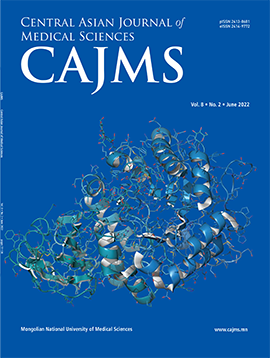Metabolic Syndrome in Women Who Have Polycystic Ovary Syndrome Related Infertility
DOI:
https://doi.org/10.24079/cajms.2021.09.011Keywords:
Polycystic Ovary, Metabolic Syndromes, Female InfertilityAbstract
Objective: The aim of the present study was to determine the prevalence of metabolic syndrome (MS) in infertile Mongolian women with polycystic ovary syndrome (PCOS) using the International Diabetes Federation (IDF) criteria. Methods: We used the case control retrospective study designs. Total 1340 infertile women enrolled in this study. Among the women, 114 were found with PCOS by Rotterdam’s criteria at the Infertility and reproductive department, National Center for Maternal and Child Health, between December 2018 and 2019. The IDF diagnostic criteria for metabolic syndrome (MS) was used. The PCOS patients were divided into the following groups: (1) cases (with MS, n = 42) and (2) controls (without MS, n = 72). Results: The average age, body mass index (BMI), and duration of infertility were 28.7 ± 4.1 years, 27.3 ± 5.2 kg/m² and 4.4 ± 3.1y, respectively. Among the patients 57.9% of them had oligomenorrhea, 22.8% had amenorrhea, 57.0% had primary infertility, 51.9% had hirsutism and 50.8% had acne. As a result of hormone assays, LH was 9.3±3.5mIU/ml, LH/FSH ratio was 1.6 ± 0.83 [0.1-3.6], and AMH was 6.1ng/ml ± 3.6 [2.9 - 21.0]. The prevalence of MS was 36.8%. The variables which include age (30.9 ± 4.9), body mass (75.9 ± 11.6kg), and also some metabolic parameters such as hypertension (133.6/88.4 ± 13.6 mm Hg), WC (94.1 ± 8.6 cm) and high triglyceride (1.8 ± 1.0 mmol/l) were observed in the MS group and compared to the without MS group. Conclusions: We found out that the prevalence of metabolic syndrome was 36.8% among infertile women with PCOS. Age, BMI, WC, amenorrhea, acne, and acanthosis nigricans were highly related to metabolic syndrome.
Downloads
294
Downloads
Published
How to Cite
Issue
Section
License
Copyright (c) 2021 Mongolian National University of Medical Sciences

This work is licensed under a Creative Commons Attribution-NonCommercial 4.0 International License.




